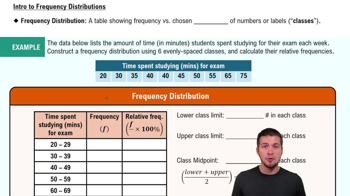Here are the essential concepts you must grasp in order to answer the question correctly.
Poisson Distribution
The Poisson distribution is a probability distribution that expresses the probability of a given number of events occurring in a fixed interval of time or space, given that these events happen with a known constant mean rate and independently of the time since the last event. It is particularly useful for modeling rare events, such as the number of births in a day.
Recommended video:
Intro to Frequency Distributions
Mean (λ) in Poisson Distribution
In the context of the Poisson distribution, the mean (denoted as λ, lambda) represents the average number of occurrences of the event in the specified interval. For the given problem, λ would be calculated by dividing the total number of births (5942) by the number of days (365), which gives the expected number of births per day.
Recommended video:
Mean & Standard Deviation of Binomial Distribution
Calculating Probability with Poisson
To find the probability of observing exactly k events (in this case, 16 births) in a Poisson distribution, the formula P(X = k) = (e^(-λ) * λ^k) / k! is used, where e is the base of the natural logarithm, λ is the mean number of events, and k! is the factorial of k. This formula allows us to compute the likelihood of a specific number of occurrences given the average rate.
Recommended video:
Probability From Given Z-Scores - TI-84 (CE) Calculator
 Verified step by step guidance
Verified step by step guidance Verified video answer for a similar problem:
Verified video answer for a similar problem:



 7:09m
7:09m